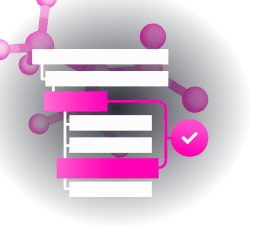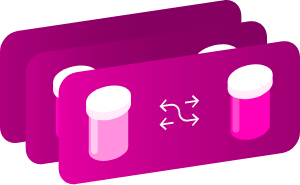Explore a selection of our essential drug information below, or:
Identification
- Summary
Cystine is an oxidated derivative of the amino acid cysteine found in various nutritional products, acne treatments, and creams to treat cervical injury or inflammation.
- Generic Name
- Cystine
- DrugBank Accession Number
- DB00138
- Background
A covalently linked dimeric nonessential amino acid formed by the oxidation of cysteine. Two molecules of cysteine are joined together by a disulfide bridge to form cystine.
- Type
- Small Molecule
- Groups
- Approved, Nutraceutical
- Structure
- Weight
- Average: 240.3
Monoisotopic: 240.023848262 - Chemical Formula
- C6H12N2O4S2
- Synonyms
- (R,R)-3,3'-dithiobis(2-aminopropanoic acid)
- Cistina
- Cystine
- L-alpha-Diamino-beta-dithiolactic acid
- L-Cystine
- L-Dicysteine
- β,β'-dithiodialanine
Pharmacology
- Indication
It has been claimed that L-cysteine has anti-inflammatory properties, that it can protect against various toxins, and that it might be helpful in osteoarthritis and rheumatoid arthritis. More research will have to be done before L-cysteine can be indicated for any of these conditions. Research to date has mostly been in animal models.
 Reduce drug development failure ratesBuild, train, & validate machine-learning modelswith evidence-based and structured datasets.Build, train, & validate predictive machine-learning models with structured datasets.
Reduce drug development failure ratesBuild, train, & validate machine-learning modelswith evidence-based and structured datasets.Build, train, & validate predictive machine-learning models with structured datasets.- Associated Conditions
Indication Type Indication Combined Product Details Approval Level Age Group Patient Characteristics Dose Form Adjunct therapy in treatment of Acne ••• ••• •••••• Used in combination to treat Alopecia Combination Product in combination with: Pantothenic acid (DB01783) ••• ••• ••••• ••••••• Adjunct therapy in treatment of Atrophic dermatitis ••• ••• •••••• Used in combination to treat Hair damage Combination Product in combination with: Pantothenic acid (DB01783) ••• ••• ••••• ••••••• Used in combination to treat Nail growth abnormal Combination Product in combination with: Pantothenic acid (DB01783) ••• ••• ••••• ••••••• - Associated Therapies
- Contraindications & Blackbox Warnings
 Prevent Adverse Drug Events TodayTap into our Clinical API for life-saving information on contraindications & blackbox warnings, population restrictions, harmful risks, & more.Avoid life-threatening adverse drug events with our Clinical API
Prevent Adverse Drug Events TodayTap into our Clinical API for life-saving information on contraindications & blackbox warnings, population restrictions, harmful risks, & more.Avoid life-threatening adverse drug events with our Clinical API- Pharmacodynamics
L-Cystine is a covalently linked dimeric nonessential amino acid formed by the oxidation of cysteine. Two molecules of cysteine are joined together by a disulfide bridge to form cystine. Cystine is a chemical substance which naturally occurs as a deposit in the urine, and can form a calculus (hard mineral formation) when deposited in the kidney. The compound produced when two cysteine molecules linked by a disulfide (S-S) bond. Cystine is required for proper vitamin B6 utilization and is also helpful in the healing of burns and wounds, breaking down mucus deposits in illnesses such as bronchitis as well as cystic fibrosis. Cysteine also assists in the supply of insulin to the pancreas, which is needed for the assimilation of sugars and starches. It increases the level of glutathione in the lungs, liver, kidneys and bone marrow, and this may have an anti-aging effect on the body by reducing age-spots etc.
- Mechanism of action
Certain conditions, e.g. an acetaminophen overdose, deplete hepatic glutathione and subject the tissues to oxidative stress resulting in loss of cellular integrity. L-Cystine serves as a major precursor for synthesis of glutathione.
Target Actions Organism UCystine/glutamate transporter Not Available Humans UCystinosin Not Available Humans - Absorption
Not Available
- Volume of distribution
Not Available
- Protein binding
Not Available
- Metabolism
- Not Available
- Route of elimination
Not Available
- Half-life
Not Available
- Clearance
Not Available
- Adverse Effects
 Improve decision support & research outcomesWith structured adverse effects data, including: blackbox warnings, adverse reactions, warning & precautions, & incidence rates. View sample adverse effects data in our new Data Library!Improve decision support & research outcomes with our structured adverse effects data.
Improve decision support & research outcomesWith structured adverse effects data, including: blackbox warnings, adverse reactions, warning & precautions, & incidence rates. View sample adverse effects data in our new Data Library!Improve decision support & research outcomes with our structured adverse effects data.- Toxicity
With typical doses of 1 to 1.5 grams daily, the most commonly reported side effects have been gastrointestinal, such as nausea. There are rare reports of cystine renal stone formation, Single injections of L-cysteine (0.6-1.5 g/kg) into 4-day-old pups resulted in massive damage to cortical neurons, permanent retinal dystrophy, atrophy of the brain and hyperactivity.
- Pathways
- Not Available
- Pharmacogenomic Effects/ADRs
- Not Available
Interactions
- Drug Interactions
- This information should not be interpreted without the help of a healthcare provider. If you believe you are experiencing an interaction, contact a healthcare provider immediately. The absence of an interaction does not necessarily mean no interactions exist.Not Available
- Food Interactions
- Not Available
Products
 Drug product information from 10+ global regionsOur datasets provide approved product information including:dosage, form, labeller, route of administration, and marketing period.Access drug product information from over 10 global regions.
Drug product information from 10+ global regionsOur datasets provide approved product information including:dosage, form, labeller, route of administration, and marketing period.Access drug product information from over 10 global regions.- Mixture Products
Name Ingredients Dosage Route Labeller Marketing Start Marketing End Region Image Amino-cerv Cystine (0.354 %) + Inositol (0.83 %) + Sodium propionate (0.50 %) + Racemethionine (0.83 %) + Urea (8.34 %) Cream Vaginal Milex, A Coopersurgical Co. 1952-12-31 2007-07-26 Canada Bio-Life Pil-Food Capsule Cystine (105 mg) + Biotin (0.2 mg) + Millet seed (20 mg) + Pantothenic acid (25 mg) + Pyridoxine hydrochloride (12.15 mg) + Racemethionine (200 mg) + Riboflavin (1 mg) + Vitamin E (3 IU) + alpha-Lactalbumin (25 mg) Capsule Oral BIO-LIFE MARKETING SDN. BHD. 2020-09-08 Not applicable Malaysia Distilpure Msm Cystine (0.05 g/100g) + Biotin (0.02 g/100g) + Cysteine (0.02 g/100g) + Methionine (0.02 g/100g) + Thiamine chloride (0.02 g/100g) Powder Topical Mbg Inc (Korea Institute of Science Development) 2017-09-16 2018-09-16 US Medi Msm (methyl Sulfonyl Methane) Cystine (0.05 g/100g) + Biotin (0.02 g/100g) + Cysteine (0.02 g/100g) + Methionine (0.02 g/100g) + Thiamine chloride (0.02 g/100g) Powder Topical Mbg Inc (Korea Institute of Science Development) 2016-09-16 2016-09-16 US Pantogar - Kapseln Cystine (220 mg) + Calcium pantothenate (60 mg) Capsule Oral Merz Pharma Austria Gmb H 1986-10-31 Not applicable Austria - Unapproved/Other Products
Name Ingredients Dosage Route Labeller Marketing Start Marketing End Region Image Distilpure Msm Cystine (0.05 g/100g) + Biotin (0.02 g/100g) + Cysteine (0.02 g/100g) + Methionine (0.02 g/100g) + Thiamine chloride (0.02 g/100g) Powder Topical Mbg Inc (Korea Institute of Science Development) 2017-09-16 2018-09-16 US Medi Msm (methyl Sulfonyl Methane) Cystine (0.05 g/100g) + Biotin (0.02 g/100g) + Cysteine (0.02 g/100g) + Methionine (0.02 g/100g) + Thiamine chloride (0.02 g/100g) Powder Topical Mbg Inc (Korea Institute of Science Development) 2016-09-16 2016-09-16 US
Categories
- Drug Categories
- Chemical TaxonomyProvided by Classyfire
- Description
- This compound belongs to the class of organic compounds known as l-cysteine-s-conjugates. These are compounds containing L-cysteine where the thio-group is conjugated.
- Kingdom
- Organic compounds
- Super Class
- Organic acids and derivatives
- Class
- Carboxylic acids and derivatives
- Sub Class
- Amino acids, peptides, and analogues
- Direct Parent
- L-cysteine-S-conjugates
- Alternative Parents
- L-alpha-amino acids / Dicarboxylic acids and derivatives / Dialkyldisulfides / Amino acids / Sulfenyl compounds / Carboxylic acids / Organopnictogen compounds / Organic oxides / Monoalkylamines / Hydrocarbon derivatives show 1 more
- Substituents
- Aliphatic acyclic compound / Alpha-amino acid / Amine / Amino acid / Carbonyl group / Carboxylic acid / Dialkyldisulfide / Dicarboxylic acid or derivatives / Hydrocarbon derivative / L-alpha-amino acid show 12 more
- Molecular Framework
- Aliphatic acyclic compounds
- External Descriptors
- non-proteinogenic L-alpha-amino acid, L-cysteine derivative, cystine (CHEBI:16283)
- Affected organisms
- Humans and other mammals
Chemical Identifiers
- UNII
- 48TCX9A1VT
- CAS number
- 56-89-3
- InChI Key
- LEVWYRKDKASIDU-IMJSIDKUSA-N
- InChI
- InChI=1S/C6H12N2O4S2/c7-3(5(9)10)1-13-14-2-4(8)6(11)12/h3-4H,1-2,7-8H2,(H,9,10)(H,11,12)/t3-,4-/m0/s1
- IUPAC Name
- (2R)-2-amino-3-{[(2R)-2-amino-2-carboxyethyl]disulfanyl}propanoic acid
- SMILES
- N[C@@H](CSSC[C@H](N)C(O)=O)C(O)=O
References
- Synthesis Reference
Peter Stehle, Peter Furst, Werner Fekl, "N,N'-bis-L-amino acid-L-cystine-peptide containing amino acid preparations for oral parenteral nutrition." U.S. Patent US4968696, issued February, 1964.
US4968696- General References
- Not Available
- External Links
- Human Metabolome Database
- HMDB0000192
- KEGG Drug
- D03636
- KEGG Compound
- C00491
- PubChem Compound
- 67678
- PubChem Substance
- 46506670
- ChemSpider
- 60997
- 3036
- ChEBI
- 16283
- ChEMBL
- CHEMBL590540
- ZINC
- ZINC000001532673
- PharmGKB
- PA449176
- PDBe Ligand
- IYY
- PDRhealth
- PDRhealth Drug Page
- Wikipedia
- Cystine
- PDB Entries
- 7zkw / 8dkm
- MSDS
- Download (72 KB)
Clinical Trials
- Clinical Trials
Clinical Trial & Rare Diseases Add-on Data Package
Explore 4,000+ rare diseases, orphan drugs & condition pairs, clinical trial why stopped data, & more. Preview package Phase Status Purpose Conditions Count Start Date Why Stopped 100+ additional columns Unlock 175K+ rows when you subscribe.View sample data3 Completed Treatment Infertility 1 somestatus stop reason just information to hide
Pharmacoeconomics
- Manufacturers
- Not Available
- Packagers
- Mason Distributors
- Tyson & Associates Inc.
- Dosage Forms
Form Route Strength Cream Vaginal Tablet Oral Powder Topical Capsule Oral - Prices
Unit description Cost Unit L-alanine 600 mg capsule 0.35USD capsule A-ketoglut acid 500 mg capsule 0.31USD capsule Amino acid capsule 0.08USD capsule DrugBank does not sell nor buy drugs. Pricing information is supplied for informational purposes only.- Patents
- Not Available
Properties
- State
- Solid
- Experimental Properties
Property Value Source melting point (°C) 260.5 dec °C PhysProp water solubility 190 mg/L (at 20 °C) YALKOWSKY,SH & DANNENFELSER,RM (1992) logP -5.08 CHMELIK,J ET AL. (1991) pKa 1 MERCK INDEX (1996) - Predicted Properties
Property Value Source Water Solubility 16.8 mg/mL ALOGPS logP -3.2 ALOGPS logP -5.9 Chemaxon logS -1.2 ALOGPS pKa (Strongest Acidic) 1.56 Chemaxon pKa (Strongest Basic) 9.34 Chemaxon Physiological Charge 0 Chemaxon Hydrogen Acceptor Count 6 Chemaxon Hydrogen Donor Count 4 Chemaxon Polar Surface Area 126.64 Å2 Chemaxon Rotatable Bond Count 7 Chemaxon Refractivity 54.87 m3·mol-1 Chemaxon Polarizability 22.77 Å3 Chemaxon Number of Rings 0 Chemaxon Bioavailability 1 Chemaxon Rule of Five Yes Chemaxon Ghose Filter No Chemaxon Veber's Rule No Chemaxon MDDR-like Rule No Chemaxon - Predicted ADMET Features
Property Value Probability Human Intestinal Absorption + 0.7309 Blood Brain Barrier - 0.5098 Caco-2 permeable - 0.7541 P-glycoprotein substrate Non-substrate 0.606 P-glycoprotein inhibitor I Non-inhibitor 0.9749 P-glycoprotein inhibitor II Non-inhibitor 1.0 Renal organic cation transporter Non-inhibitor 0.9521 CYP450 2C9 substrate Non-substrate 0.9012 CYP450 2D6 substrate Non-substrate 0.8371 CYP450 3A4 substrate Non-substrate 0.8232 CYP450 1A2 substrate Non-inhibitor 0.8924 CYP450 2C9 inhibitor Non-inhibitor 0.8968 CYP450 2D6 inhibitor Non-inhibitor 0.9149 CYP450 2C19 inhibitor Non-inhibitor 0.9101 CYP450 3A4 inhibitor Non-inhibitor 0.6103 CYP450 inhibitory promiscuity Low CYP Inhibitory Promiscuity 0.995 Ames test Non AMES toxic 0.5429 Carcinogenicity Non-carcinogens 0.781 Biodegradation Ready biodegradable 0.628 Rat acute toxicity 2.0474 LD50, mol/kg Not applicable hERG inhibition (predictor I) Weak inhibitor 0.9839 hERG inhibition (predictor II) Non-inhibitor 0.9707
Spectra
- Mass Spec (NIST)
- Download (2.96 KB)
- Spectra
- Chromatographic Properties
Collision Cross Sections (CCS)
Adduct CCS Value (Å2) Source type Source [M-H]- 156.5186047 predictedDarkChem Lite v0.1.0 [M-H]- 156.5333047 predictedDarkChem Lite v0.1.0 [M-H]- 156.6452047 predictedDarkChem Lite v0.1.0 [M-H]- 156.6999047 predictedDarkChem Lite v0.1.0 [M-H]- 140.53249 predictedDeepCCS 1.0 (2019) [M+H]+ 156.6924047 predictedDarkChem Lite v0.1.0 [M+H]+ 148.1189348 predictedDarkChem Standard v0.1.0 [M+H]+ 156.6622047 predictedDarkChem Lite v0.1.0 [M+H]+ 156.4245047 predictedDarkChem Lite v0.1.0 [M+H]+ 142.92804 predictedDeepCCS 1.0 (2019) [M+Na]+ 155.7846047 predictedDarkChem Lite v0.1.0 [M+Na]+ 155.6069047 predictedDarkChem Lite v0.1.0 [M+Na]+ 155.7902047 predictedDarkChem Lite v0.1.0 [M+Na]+ 155.8434047 predictedDarkChem Lite v0.1.0 [M+Na]+ 149.29123 predictedDeepCCS 1.0 (2019)
Targets

- Kind
- Protein
- Organism
- Humans
- Pharmacological action
- Unknown
- General Function
- Cystine:glutamate antiporter activity
- Specific Function
- Sodium-independent, high-affinity exchange of anionic amino acids with high specificity for anionic form of cystine and glutamate.
- Gene Name
- SLC7A11
- Uniprot ID
- Q9UPY5
- Uniprot Name
- Cystine/glutamate transporter
- Molecular Weight
- 55422.44 Da
References
- Tomi M, Hosoya K, Takanaga H, Ohtsuki S, Terasaki T: Induction of xCT gene expression and L-cystine transport activity by diethyl maleate at the inner blood-retinal barrier. Invest Ophthalmol Vis Sci. 2002 Mar;43(3):774-9. [Article]
- Hosoya K, Tomi M, Ohtsuki S, Takanaga H, Saeki S, Kanai Y, Endou H, Naito M, Tsuruo T, Terasaki T: Enhancement of L-cystine transport activity and its relation to xCT gene induction at the blood-brain barrier by diethyl maleate treatment. J Pharmacol Exp Ther. 2002 Jul;302(1):225-31. [Article]
- Ruiz E, Siow RC, Bartlett SR, Jenner AM, Sato H, Bannai S, Mann GE: Vitamin C inhibits diethylmaleate-induced L-cystine transport in human vascular smooth muscle cells. Free Radic Biol Med. 2003 Jan 1;34(1):103-10. [Article]
- Bridges CC, Zalups RK: Cystine and glutamate transport in renal epithelial cells transfected with human system x(-) (c). Kidney Int. 2005 Aug;68(2):653-64. [Article]
- Tomi M, Funaki T, Abukawa H, Katayama K, Kondo T, Ohtsuki S, Ueda M, Obinata M, Terasaki T, Hosoya K: Expression and regulation of L-cystine transporter, system xc-, in the newly developed rat retinal Muller cell line (TR-MUL). Glia. 2003 Sep;43(3):208-17. [Article]
- Kind
- Protein
- Organism
- Humans
- Pharmacological action
- Unknown
- General Function
- L-cystine transmembrane transporter activity
- Specific Function
- Cystine/H(+) symporter thought to transport cystine out of lysosomes. Plays an important role in melanin synthesis, possibly by preventing melanosome acidification and subsequent degradation of tyr...
- Gene Name
- CTNS
- Uniprot ID
- O60931
- Uniprot Name
- Cystinosin
- Molecular Weight
- 41737.6 Da
References
- Kalatzis V, Cherqui S, Antignac C, Gasnier B: Cystinosin, the protein defective in cystinosis, is a H(+)-driven lysosomal cystine transporter. EMBO J. 2001 Nov 1;20(21):5940-9. [Article]
Transporters
- Kind
- Protein
- Organism
- Humans
- Pharmacological action
- Unknown
- Actions
- Inhibitor
- General Function
- Transporter activity
- Specific Function
- Sodium-independent transporter that mediates the update of aromatic acid. Can function as a net efflux pathway for aromatic amino acids in the basosolateral epithelial cells (By similarity).
- Gene Name
- SLC16A10
- Uniprot ID
- Q8TF71
- Uniprot Name
- Monocarboxylate transporter 10
- Molecular Weight
- 55492.07 Da
References
- Kim DK, Kanai Y, Chairoungdua A, Matsuo H, Cha SH, Endou H: Expression cloning of a Na+-independent aromatic amino acid transporter with structural similarity to H+/monocarboxylate transporters. J Biol Chem. 2001 May 18;276(20):17221-8. Epub 2001 Feb 20. [Article]
- Kind
- Protein
- Organism
- Humans
- Pharmacological action
- Unknown
- General Function
- Peptide antigen binding
- Specific Function
- Involved in the high-affinity, sodium-independent transport of cystine and neutral and dibasic amino acids (system b(0,+)-like activity). Thought to be responsible for the high-affinity reabsorptio...
- Gene Name
- SLC7A9
- Uniprot ID
- P82251
- Uniprot Name
- b(0,+)-type amino acid transporter 1
- Molecular Weight
- 53480.81 Da
References
- Rius M, Sala L, Chillaron J: The role of N-glycans and the C-terminal loop of the subunit rBAT in the biogenesis of the cystinuria-associated transporter. Biochem J. 2016 Feb 1;473(3):233-44. doi: 10.1042/BJ20150846. Epub 2015 Nov 4. [Article]
- Chillaron J, Font-Llitjos M, Fort J, Zorzano A, Goldfarb DS, Nunes V, Palacin M: Pathophysiology and treatment of cystinuria. Nat Rev Nephrol. 2010 Jul;6(7):424-34. doi: 10.1038/nrneph.2010.69. Epub 2010 Jun 1. [Article]
- Nagamori S, Wiriyasermkul P, Guarch ME, Okuyama H, Nakagomi S, Tadagaki K, Nishinaka Y, Bodoy S, Takafuji K, Okuda S, Kurokawa J, Ohgaki R, Nunes V, Palacin M, Kanai Y: Novel cystine transporter in renal proximal tubule identified as a missing partner of cystinuria-related plasma membrane protein rBAT/SLC3A1. Proc Natl Acad Sci U S A. 2016 Jan 19;113(3):775-80. doi: 10.1073/pnas.1519959113. Epub 2016 Jan 6. [Article]
- Kind
- Protein
- Organism
- Humans
- Pharmacological action
- Unknown
- General Function
- L-cystine transmembrane transporter activity
- Specific Function
- Involved in the high-affinity, sodium-independent transport of cystine and neutral and dibasic amino acids (system B(0,+)-like activity). May function as an activator of SLC7A9 and be involved in t...
- Gene Name
- SLC3A1
- Uniprot ID
- Q07837
- Uniprot Name
- Neutral and basic amino acid transport protein rBAT
- Molecular Weight
- 78851.4 Da
References
- Nagamori S, Wiriyasermkul P, Guarch ME, Okuyama H, Nakagomi S, Tadagaki K, Nishinaka Y, Bodoy S, Takafuji K, Okuda S, Kurokawa J, Ohgaki R, Nunes V, Palacin M, Kanai Y: Novel cystine transporter in renal proximal tubule identified as a missing partner of cystinuria-related plasma membrane protein rBAT/SLC3A1. Proc Natl Acad Sci U S A. 2016 Jan 19;113(3):775-80. doi: 10.1073/pnas.1519959113. Epub 2016 Jan 6. [Article]
- Chillaron J, Font-Llitjos M, Fort J, Zorzano A, Goldfarb DS, Nunes V, Palacin M: Pathophysiology and treatment of cystinuria. Nat Rev Nephrol. 2010 Jul;6(7):424-34. doi: 10.1038/nrneph.2010.69. Epub 2010 Jun 1. [Article]
Drug created at June 13, 2005 13:24 / Updated at April 09, 2024 18:11

